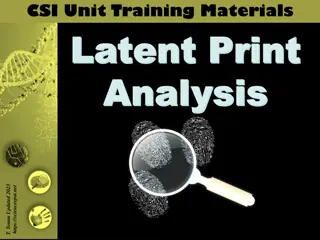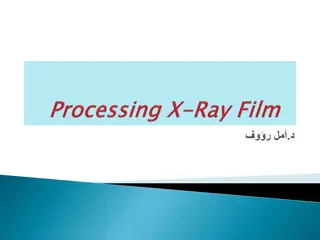Understanding Latent Print Development Techniques
Latent prints, hidden impressions left behind by sweat pores on surfaces, can be developed using physical and chemical methods. Factors affecting latent prints include surface type, movement during contact, handling, and environmental conditions. Various surfaces require specific development techniques, such as cyanoacrylate for nonporous surfaces and amino acid methods for absorbent surfaces. Crime scene investigations involve visual inspection, proper documentation, and sequential processing to uncover latent fingerprints effectively.
- Latent prints
- Development techniques
- Crime scene investigation
- Surface types
- Fingerprint development
Download Presentation

Please find below an Image/Link to download the presentation.
The content on the website is provided AS IS for your information and personal use only. It may not be sold, licensed, or shared on other websites without obtaining consent from the author. Download presentation by click this link. If you encounter any issues during the download, it is possible that the publisher has removed the file from their server.
E N D
Presentation Transcript
Development of Latent Prints Physical & Chemical Techniques
Latent Print Latent means hidden, and the prints must be developed to make them usable and identifiable. A chance impression caused by perspiration through the sweat pores on the friction ridges of the skin being transferred to another surface. Three things must be present for a quality latent print to be deposited, a sufficient transfer medium, a suitable substrate or surface, and appropriate handling of the object. Latent fingerprint development may be achieved with a wide array of optical, physical, and chemical processes
Conditions Affecting Latent Prints The best surface is smooth, clean, and glossy or nonporous. Coarse cloth, grained leather, unfinished wood, and stippled surfaces generally are poor candidates. Type of surface If the finger moves slightly while in contact with the object, ridge detail may be lost or distorted beyond usability. Many times, the pattern area may be smudged but other areas may be clear. Manner in which the object was touched Weather May dry out or wash away the print, especially if the print is on an exterior surface. Humidity May cause print to be absorbed into a surface or to dissipate. May obliterate print if both ridges and valleys are covered. The more oil deposited with perspiration, the longer the latent will last. Oil is transferred to the fingers from the hairy area of the body. Frequently there is no oil in the perspiration of the finger. Perspiration Was the object simply handled and set down? Was the object used as a weapon? Was the object used as a pry tool? Use of the object Most suspects are not concerned about the way in which they handle items. Suspects are usually in a hurry in a burglary or other crime, and as such, they are not careful about what they do and how they do it Care of the suspect
Surface Types Nonporous surfaces Porous substrates Do not absorb. These surfaces repel moisture and often appear polished. Include glass, metal, plastics, lacquered or painted wood, and rubber. Latent prints on these substrates are more susceptible to damage because the fingerprint residue resides on the outermost surface. Cyanoacrylate (CA), dye stains, powders, and vacuum metal deposition are usually the best choices to use on these surfaces Absorbent Include materials like paper, cardboard, wood, and other forms of cellulose. Fingerprints deposited onto these media absorb into the substrate and are somewhat durable. Amino acid techniques are particularly useful here because the amino acids tend to remain stationary when absorbed and do not migrate. SEMIPOROUS
The Crime Scene Search and Fingerprint Development Visual inspection with a bright light, forensic light source, or laser Documentation of developed prints at each step Sequential latent print processing Point of entry (POE): This is the area where the suspect had to use the most force and energy to gain entry, and the likelihood of the presence of latent fingerprints is greater. Available light (ambient light/flashlight/ALS/ultraviolet) Powder(s) DFO Ninhydrin Dye stain Photos should be done with and without a scale - Overalls of the item where the print was developed should be taken, as well as close-ups showing the print itself. Lift card should contain : Case/report number Date/time Scene address Person making the lift Type of object Place of lift (Note: A sketch should be made on the card near the lift)
Latent Print Powders Application of finely divided particles that physically adhere to the aqueous and oily components in latent print residue on nonporous surfaces. Fingerprint dusting relies on the adherence of powder (Mechanical attraction) to moisture and oily components of the latent print residue to provide good visibility and definition of fingerprint detail. Powdering is not recommended for porous or highly absorbent surfaces such as uncoated paper or raw wood.
Latent Print Powders Two essential elements Pigment Provides for effective visualization, offering contrast and definition against the background surface. Particles that serve as good fingerprint powders include carbon black (colloidal carbon), lamp black, talc, kaolin, aluminum, metal flake, and dolomite Binder/carrier Provides for maximum and preferential adhesion to latent print residue. Good binders include iron powder, corn starch, rosin, and gum Arabic.
Latent Print Powders : Magnetic or magna powder Allows for application with a magnetized rod that has no bristles. This type of powder can be light, dark, or fluorescent and utilizes the ferromagnetic properties of iron powder mixed with pigment powders. The magnetized applicator (magna brush) is dipped into the powder, picking up a ball of the iron and particle mixture, essentially forming its own Causes less damage to fragile latent prints. Magnetic powders are usually less effective on ferromagnetic substrates such as steel or nickel and are therefore not recommended on those substrates. The magnetic attraction may cause contact between the applicator and substrate, damaging latent prints in the process. In addition, magnetized particles from the powder will cling to the substrate and resist removal
Latent Print Powders : Fluorescent powder Relies on the principle of luminescence to provide contrast between fingerprint and background. Fluorescent powders are typically created by adding a laser dye in solution to a binder and allowing the mixture to evaporate. The resulting dried mass is then ground into latent print powder. Advantage Less activity is required to develop latent prints, thus lessening the likelihood of destruction of the print. Disadvantage Additional luminescence is required in the form of an alternate light source (ALS) or light amplification by stimulated emission of radiation (laser) to make the print usable.
Ninhydrin Ninhydrin was first described in 1910 when Siegfried Ruhemann mistakenly prepared the compound. Ruhemann observed that the new compound reacted with skin and amino acids to produce a purple product.
Ninhydrin Sweat Residue contain a small, but detectable, amount of amino acids, averaging about 250 ng per fingerprint. After the water evaporates from the surface, the amino acids remain as solid material. Ninhydrin reacts with the amino acids, peptides, and protein contained in the print. This technique can by applied by : spray, swabbing, or dipping method. This chemical is used on items such as paper, cardboard, and unfinished wood. The desired temperature is approximately 80 C, with a humidity rate of approximately 80 percent.
Post treatment of Prints developed by Ninhydrin The UV-to-visible light spectrum : = 407 nm and = 582 nm Treatment with zinc chloride and using the light of an argon ion laser. Post treatment with metal salts: zinc, cadmium, cobalt, and copper Formation of a metal-salt complex alters the color of Ruhemann s purple from deep violet to red or orange, depending upon the salt used. Post-treated fingerprints may be further enhanced by viewing under 490 nm light (for zinc-treated residues) or 510 nm light (for cadmium-treated residues)
Ninhydrin Analogues- DFO 1,8-Diazafluoren-9-one Best used through dipping or swabbing the piece of evidence. ALS or laser is required for visualization. The reaction is with amino acids, peptides, and protein contained in the print. The product of this reaction is pink to red in color with max of approximately 560 nm and a weaker absorption at 520 nm Unlike the ninhydrin reaction, the DFO reaction requires a high- temperature, low-humidity environment .More sensitive fingerprint development reagent than ninhydrin.
Iodine Fuming Iodine is absorbed by the fingerprint secretion, which produces a dark brownish to blackish appearance. Iodine interacts with Fatty acids and lipids contained in the fingerprint. Tend to work on relatively fresh prints. Technique is used for paper and may be used on human skin. resulting prints that develop must be photographed as the prints tend to fade over time Method of application: Fuming gun, Fuming Cabinet,
Developed print fades over time Lab set up for Iodine fuming
Cyanoacrylate Ester Reacts with the amino acids and fatty acids in the perspiration to form a white colored polymer. Suitable for metal, glass, plastic, garbage bags, electrical tape, and many other nonporous surfaces. Method of Application: Fuming chamber & CAE wand Enhancement : Variety of powders or dye stains can be used along with ALS or laser. Disadvantage : May aggravate the mucous glands and membranes.
a) Fresh Fingerprint on stainless steel b) Old Fingerprint on stainless steel c) Fresh Fingerprint on Aluminum Surface d) Old Fingerprint on Aluminum Surface
Sticky-side powder/ Gentian Violet (Crystal Violet) Used to develop prints on the adhesive side of tape. Gentian violet is used by dipping the item into a bath of the material. Sticky Side Powder may also be used in a bath, or by painting the adhesive surface. The specimen to be treated is simply immersed in or floated on a 0.1% w/v aqueous solution of gentian violet for one to two minutes and then rinsed with water. Repeated stain/rinse cycles may be used to intensify the color of the stains. With some types of tape a clearing solution of 1 M hydrochloric acid is used as the final rinse, to remove background staining without affecting the developed prints.
Small Particle Reagent A suspension Small particle reagent (SPR) technique is an effective method to develop latent fingermarks on moist, non porous surfaces. The method is based on the adherence of fine particles of treating solution to the oily or fatty components of latent fingermark residues. Consists of a suspension of fine molybdenum disulfide particles in an aqueous medium containing detergent solution (as surfactant). The gray, shiny prints that are developed with SPR can be lifted (after drying) with Gel lifters, Instant Lifters or tape.
Analogs That React with Blood Leuco-malachite Green Leuco-Crystal Violet Amido Black/Sudan Black Luminol When sprayed on the suspected area, the prints will turn a greenish color. When sprayed on the suspected area, the prints will turn purplish- black. When sprayed on the suspected area, the prints will turn dark bluish-black. When sprayed on the suspected area, the prints will fluoresce. The challenge with this technique is that it must be undertaken in a darkened environment. Luminol prints must be photographed at the time of fluorescence because when luminol stops reacting with the blood, the prints will no longer be visible.
Procedure After Developing Prints The photos should be done with and without a scale. The best type of scale is the ABFO, L type of scale. Overalls of the item where the print was developed should be taken, as well as close-ups showing the print itself. Decision must be made whether the entire item will be taken or whether the print will be lifted from the item. When appropriate, the entire item or object should be retained for use in court. Lift card should have appropriate information. Take elimination prints from victims, and witnesses where appropriate. Care and transportation of the evidence: a. Ensure the chain of custody is recorded to provide accountability. b. If items need to be secured, ensure proper securing of the item s by top and bottom, or in a place least likely to damage the item or fingerprints























